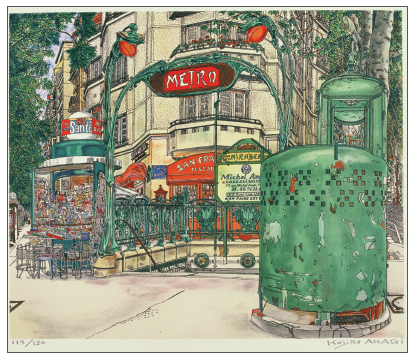A l’entrée du pont Mirabeau, côté 16e arrondissement, on trouve cette place de Barcelone qui n’a, en fait, aucun rapport avec l’Espagne. Ce sont de grandes entreprises immobilières chargées de développer ce quartier qui ont ainsi nommé les rues. A Paris, il y a un côté pratique à connaître le nom des rues, car on sait ainsi de quel quartier on parle. En 1913, à l’inauguration de cette station de métro, on redécouvre le design original imaginé par Hector Guimard, qui sera utilisé pour d’autres stations de cette ligne. En 1978, elle est inscrite aux Monuments Historiques et, depuis ce jour, on ne peut plus rien en changer, même un clou. En 1900, à l’ouverture des premières lignes de métro, la mode est à l’Art nouveau, mais en 1906, l’Art nouveau n’est plus au goût du jour. De nouveaux styles apparaissent et, grâce à cela, certaines décorations issues de l’Art nouveau sont récupérées pour être réutilisées dans d’autres stations, comme ce fut le cas pour la station Mirabeau. A la sortie de celle-ci, le kiosque à journaux est l’exemple même d’un style plus contemporain. Il reste encore des toilettes publiques pour hommes datant du 19e siècle, appelées «vespasiennes». On les appelait aussi «escargot», parce que leur structure en métal permettait de circuler à intérieur en tournant en spirale. Cela faisait partie du paysage parisien typique d’autrefois. C’est un équipement public dont la première apparition date de 1841, car la ville était souillée par des gens qui urinaient dans la rue après avoir bu trop de vin ou de bière. Au milieu coulait l’eau, on pouvait apercevoir les pieds des gens, il y avait des incrustations de tartre et de mauvaises odeurs se répandaient alentour. Les tailles de ces «escargots» ont diminué avec le temps et celui qui restait sur cette place, a été enlevé en avril 1999. Il faisait partie des deux derniers survivants, alors qu’à une certaine époque, il y en avait plus de 1200 dans tout Paris. Aujourd’hui, les vespasiennes ont été remplacées par des équipements en béton appelé «sanisette». Tout cela fait partie des équipements de la ville de Paris qui étaient courants au 20e siècle et j’en éprouve une certaine nostalgie.
This is located in the 16th arrondissement after crossing the Pont Mirabeau. The contractors who built this area assigned Spanish names to the streets when it was opened, though it had nothing to do with Spain. Parisians can often guess the location of a street just by hearing its name. When the Metro was opened in 1913 the first station designed by Hector Guimard in Paris was commissioned. It was designated a historical building in 1978 and no changes are permitted now. The famous art nouveau design of the time when the first line opened in 1900 went became unfashionable and was disliked from 1906 and the new designs were being considered. Parts of the original line were still available and they were reused to reconstruct the line.As you climb out of the station there is a newspaper kiosk which is of a modern design. Beside that there is a public toilet for men called vespasiennes which were built on many sidewalks from the 19th century. Because they were made of iron and when we enter them we turn in a spiral, they are also called escargots and were typical sights in the past. Men drinking wine and beer men were causing a public nuisance since there were no public toilets so the first of these facilities appeared in 1841. They didn’t have a full door so they were exclusively for men’s use. Water flowed toward the centre and limescale built up allowing unpleasant smells to escape onto the street. Gradually they were eradicated and the one shown here was also removed in April 1999. Though more than 1200 were installed in the city in the past, this was the second last one. Now concrete public toilets called sanisettes have replaced them. This is one of many items which could often be found on the streets of Paris in the 20th century about which I feel nostalgic.
ミラボー橋を渡った、十六区側の袂で、別にスペインと関係あるわけではないが、この辺りが開けた時のゼネコン業者たちが、隣国スペインの名前を通りに割り振ったのだった。パリでは通りの名前を聞いただけで、大体あの辺りの地区かと、見当のつく便利もあるのである。地下鉄駅が一九一三年代開通した時、この路線では、パリのメトロ開通最初の、ヘクトール・ギマールデザインで作られた駅を採用した。一九七八年から歴史建造物に指定され、今では釘一本変更が許されない。一九〇〇年、第一号線開通時のアールヌーボー名デザインも、一九〇六年頃には流行が去り、もう嫌われて次のデザインが試みられていたのだから、幸いしたのだろう。在庫部品があったので、周辺路線に回した、と言うべきかも知れない。 駅を上がったところに、これはもう新しい形だが新聞キオスクがあり、十九世紀から沢山歩道に建てられていた、ベスパジエンヌと呼ばれる、男性用公衆便所も残っていた。鉄製でぐるぐる廻って入るので、エスカルゴ(蝸牛)とも呼ばれて、パリ名物風景だった。ワインやビールを飲んで、町中での立小便に困り、一八四一年に第一号が現れた公共設備。真ん中に向かって水が流れ、足元は透けて見通しだったから、男性専用だったが、水垢がつき、匂いを路上に放っていた。段々整理となって、ここのものも一九九九年四月に取り払われてしまった。昔は千二百個以上パリ市内に設備されていたのに、最後に残った二個目であった。現在はサニゼットと呼ばれる、コンクリート造りの公衆便所に変わっている。二〇世紀のあいだ、沢山街頭にあった、懐かしいパリ歩道の小道具ばかりである。

